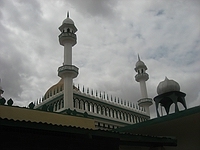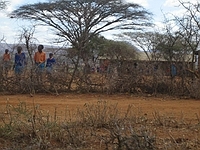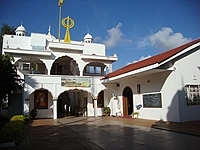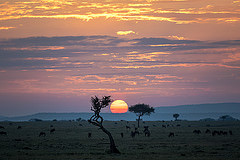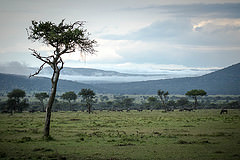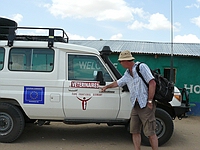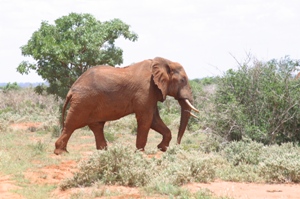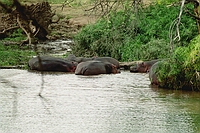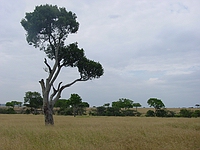Masai Mara
Written by dpi on . Posted in Nationalparks.
Sibiloi National Park
Written by admin on . Posted in Nationalparks.
On the northeastern shore of Lake Turkana lies the 1,570 square kilometer Sibiloi National Park, situated in one of Kenya’s most inhospitable regions. The average annual rainfall is barely 200 mm, and often the rainy season, which is limited to the month of April, fails to materialize altogether. In these freshwater-scarce deserts and semi-deserts, maximum temperatures can reach up to 48°C. The extensive black lava surfaces heat up so much during the day that the temperature doesn’t drop significantly at night. In contrast, there are significant temperature differences between the land and the water, creating strong thermals: for most of the year, an unrelenting hot wind whips across the land. Due to its extremely remote location – the park’s northern border runs 30 km from Ethiopia – the park is one of the least visited in Kenya. However, this combination of remoteness, unspoiled nature, and rugged landscape makes the protected area, designated in 1973, so appealing.
Due to the climatic conditions, the plant life in Sibiloi is relatively species-poor and largely consists of annual grasses and flowers that form green, blooming carpets after the sporadic rains, but for most of the year are withered or seemingly completely gone, surviving only as seeds or roots until the next rainfall. The most striking plant in the park is the pink-flowering desert rose, a drought-resistant spurge whose latex sap was used by various peoples as arrow poison for hunting. In the luggas, the dry riverbeds, acacias and doum palms grow, which can tap into groundwater veins with their extensive root systems.
Against this backdrop, the diversity of the park’s wildlife is all the more astonishing, including typical species of the arid zone of northern Kenya, such as the finely striped, large-eared Grevy’s zebra, the blue-legged Somali ostrich, the oryx antelope, the gerenuk, and the reticulated giraffe. A unique feature is the rare tiang, a subspecies of the topi antelope. Additionally, the common plains zebra is present, capable of consuming tough, dry grass, unlike ruminants. Other animals include kudus, hyenas, and Grant’s gazelles, while lions and cheetahs can be found near freshwater sources. The park also includes a one-kilometer-wide strip of water, home to numerous hippos and crocodiles. Along the water, there are many water and wading birds, including pelicans and flamingos.
Evidently, the climate was wetter in other geological eras. A well-preserved petrified forest, around 7 million years old, has been found in Sibiloi. Additionally, thousands of interesting animal fossils have been unearthed, including giant tortoises and a 14-meter-long extinct crocodile species. Just north of the park headquarters in Alia Bay, located at the southern border of the park, some of the most exciting finds of fossilized hominid bones have been made in Koobi Fora, shedding light on the origins of humans. In 1972, the famous skull 1470 of Homo habilis was found, believed to have lived in the Turkana Basin around 2 million years ago and widely regarded as a direct ancestor of humans. The prosaic naming of the find is explained by the excavation catalog number of the National Museum. There is a small museum where, in addition to hominid exhibits, parts of a 1.5-million-year-old elephant skeleton are displayed.
Off the coast of Sibiloi National Park lies Northern Island, the smallest of the three significant islands in Lake Turkana, known for its numerous venomous snakes, including cobras, puff adders, and other vipers. It is believed that these animals were driven to the island from the Omo River delta on papyrus islands.
Tsavo West National Park
Written by admin on . Posted in Nationalparks.
The Tsavo West National Park, covering an area of 9,055 square kilometers, is much more varied and diverse in its landscape than the Tsavo East National Park. Here, you encounter signs of recent volcanism in the form of lava flows and craters. There are impressive mountains, some of which are covered with dense, forest-rich vegetation, offering splendid viewpoints with views of Mount Kilimanjaro (Tanzania) when it’s not cloudy. Additionally, there’s a special rhino sanctuary where you can observe these rare giants. The area boasts two permanent water sources: Mzima Springs and the Tsavo River. Noteworthy are also the Roaring Rocks and the Poacher’s Lookout.
in 2004:
Tsavo East Nationalpark
Written by admin on . Posted in Nationalparks.
Tsavo East National Park, at 11,747 square kilometers, is significantly larger than its western counterpart. However, its landscape is less varied and much drier, with an average annual rainfall of only 510 mm. The southern part of the park is dominated by flat grass and bush savannas, which gradually transition into semi-deserts as one moves northeast from Voi, corresponding with decreasing rainfall. Unlike Tsavo West, the picturesque mountains are located outside the western park boundaries. The only contrast to this monotony are the dense, refreshingly green gallery forests along the riverbanks of the Athi or Galana River, Tiva River, and Voi River. Yet, it is precisely this expansive, boundless landscape that gives the park its unique charm.
Tsavo East is divided into three regions by the eastward-flowing Tiva and Galana Rivers. North of the Galana River, the park is an inaccessible wilderness. This area is closed to tourism.
South of the Galana River, Tsavo East is well-developed and home to most of its attractions. North of the Voi Safari Lodge lies Mudanda Rock. This nearly 2 km long, approximately 20 meters high, and 50 meters wide inselberg rises unexpectedly from the plain and can be climbed from the west via a footpath.
Following the course of the Voi River (even when it is dry), the green vegetation along its banks and the numerous waterholes in the riverbed attract wildlife from the vast, parched surroundings. During the dry season, there is no better place for observing birds, monkeys, elephants, antelopes, gazelles, lions, and leopards.
The Aruba Dam creates a small lake of up to 85 hectares by damming the Voi River, attracting thirsty animals from the Taru Desert.
Galdessa Camp Satao Camp Sentrim Tarhi Camp
Ndololo Camp
Ashnil Aruba Lodge
Voi Safari Lodge
We are currently preparing short videos for all destinations.
We are happy to answer any questions you may have about your African journey!
Aberdare Nationalpark / Nyeri
Written by admin on . Posted in Nationalparks.
Like a wild, mysterious island, the Aberdares rise from Kenya’s most densely populated area, a sea of Kikuyu villages, shambas, coffee, tea, and pyrethrum plantations. The Aberdare Range, with an elevation of 4001 meters (some maps also indicate 3999m or 3994m), is the third-highest mountain range in Kenya, stretching approximately 70 km along the eastern edge of the Rift Valley. Like most of East Africa’s mountains, they are volcanic in origin, although this is not immediately apparent as they lack the classic conical shape. Perhaps their location between Mt. Kenya and the Rift Valley – both landmarks of ongoing tectonic activity in Kenya’s crust – hints at their volcanic past. The central volcano of the Aberdares was active between 6.5 and 5 million years ago. At that time, the Rift Valley, with Lake Naivasha, had a completely different form, and Mt. Longonot did not yet exist. Around 2 million years ago, a collapse of the East African Rift tore the entire western half of the mountains into the depths. The steep, 400-600 meter deep escarpments on the western edge of the Aberdares are unmistakable traces of this gigantic process, while the eastern slopes of the mountains descend much more gently. Elevations above 3000 meters are protected by the Aberdare National Park, opened in May 1950, which, at 767 sq km, is not one of Kenya’s largest parks, but is the fourth oldest in the country after Nairobi, Tsavo, and Mt. Kenya. To the east, a densely forested part of the protected area, known as the Salient, extends almost down to Nyeri. The Karura Falls, about 280 meters high, are among the highest waterfalls in Kenya.
In Aberdare National Park, the Big Five – elephant, rhino, buffalo, leopard, and lion – can be found even at high altitudes, along with the eland antelope.
Aberdare Country Club (Nyeri)
Outspan Golf & Country Club (Nyeri)
The Ark
Treetops Lodge
We are happy to answer any questions you may have about your trip to Africa!
